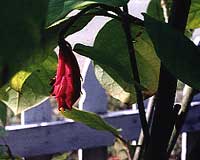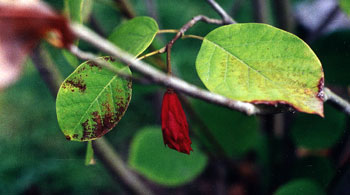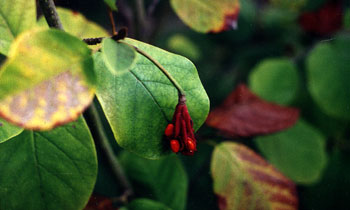 Oyama Magnolia's Autumn Seed Pods
Oyama Magnolia's Autumn Seed Pods
Magnolia sieboldi, the Oyama Magnolia, is a bush that goes through remarkable seasonal changes, so there is a separate page for some Spring photographs of Oyama Blossoms. From May & throughout summer it produces huge white upside-down cup-shaped blooms with red stamins inside. These flowers smell quite wonderful, though really it has a pleasing smell even when not in bloom, as the shiny hand-sized leaves have a comforting, vaguely medicinal odor.
As the spring & summer bloom petals drop, each flower leaves behind a green fruit which though quite large is not initially very showy, being the same color as the leaves. But as the present page shows, these long-lasting fruits eventually become highly decorative.

When we bought this Oyama, it was rootbound in a very large pot; we had a devil of a time getting it out of the pot & into the hole, it was so heavy. When we saw it in the nursery, it stood a good ten feet tall with a couple limbs straggling upward to twelve. But that was in the giant pot, it was really two feet shorter. When we got it in the ground it seemed to have shrunk, but still tall enough to provide a nice view from the kitchen window as we do the dishes, & a good contrasting shrub to the Purple Ninebark a few feet away, the stand of Evergreen Huckleberries to its opposite side, & the pink-blossoming Dawn Verbanum across the fenceline from it. The Oyama will someday be big enough that some people qualify it as a small decidious tree, but I think of it as big shrub that can get even bigger.
As the name Oyama indicates, this magnolia is from Japan, but is also found native to Korea. It's a good shrub for the Pacific Northwest, flourishing in conditions such as are loved by Rhododendrons. It would not do so well in hotter climates.
As it finishes blooming it develops hard green seedpods which in autumn get redder & redder & redder, dangling all over the branches like christmas tree decorations, quite as marvelous as had been the blooms.

I often am not wearing my glasses when in the garden so that everything is a softly-edged gentle world to my poor vision. That's why I had at first failed to notice when in September the red seedpods started bursting open. When I got on my glasses so that Granny Artemis & I could take a few pictures of this & that, it was quite a surprise to see the hard red dangling pods fully transmogrified. They looked like someone had turned them inside-out, revealing bright orange seeds that looked like chewing gum chicklets. Some of the chicklets were scattered on the ground, some were still clinging to the pods. I gathered a handful of the seeds to let "winter" on the back porch a while then to start in pots.
After the autumn leaves have yellowed then browned & fallen, & the seedpods have tossed their seeds away, the pods turn blackly shrivelled & fall off amidst the natural mulch of shed leaves. For the rest of winter it's "just" enormous twigs, but even in this sleepy cold winter is interesting to look at.